
- •Instrument transformer burden and accuracy
- •Introduction to protective relaying
- •ANSI/IEEE function number codes
- •Directional overcurrent (67) protection
- •Distance (21) protection
- •Zone overreach and underreach
- •Line impedance characteristics
- •Using impedance diagrams to characterize faults
- •Distance relay characteristics
- •Auxiliary and lockout (86) relays
- •Review of fundamental principles
- •Signal characterization
- •Flow measurement in open channels
- •Material volume measurement
- •Radiative temperature measurement
- •Analytical measurements
- •Review of fundamental principles
- •Control valves
- •Globe valves
- •Gate valves
- •Diaphragm valves
- •Ball valves
- •Disk valves
- •Dampers and louvres
- •Valve packing
- •Valve seat leakage
- •Control valve actuators
- •Pneumatic actuators
- •Hydraulic actuators
- •Electric actuators
- •Hand (manual) actuators
- •Valve failure mode
- •Direct/reverse actions
- •Available failure modes
- •Selecting the proper failure mode
- •Actuator bench-set
- •Pneumatic actuator response
- •Valve positioners
- •Electronic positioners
- •Split-ranging
- •Complementary valve sequencing
- •Exclusive valve sequencing
- •Progressive valve sequencing
- •Valve sequencing implementations
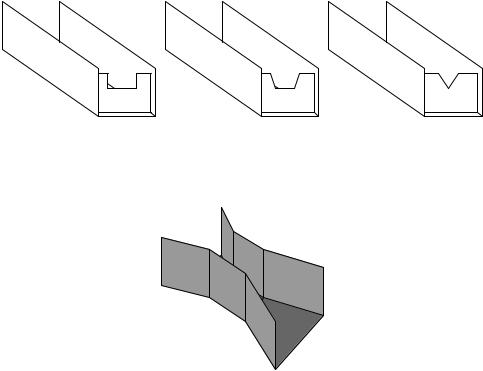
26.2. FLOW MEASUREMENT IN OPEN CHANNELS |
2067 |
26.2Flow measurement in open channels
Measuring the flow rate of liquid through an open channel is not unlike measuring the flow rate of a liquid through a closed pipe: one of the more common methods for doing so is to place a restriction in the path of the liquid flow and then measure the “pressure” dropped across that restriction. The easiest way to do this is to install a low “dam” in the middle of the channel, then measure the height of the liquid upstream of the dam as a way to infer flow rate. This dam is technically referred to as a weir, and three styles of weir are commonly used:
Different styles of weirs for measuring open-channel liquid flow
Channel
Weir |
Channel |
Channel |
Weir |
Weir |
Rectangular |
Cippoletti |
V-notch |
Another type of open-channel restriction used to measure liquid flow is called a flume. An illustration of a Parshall flume is shown here:
Weirs and flumes may be thought of being somewhat like “orifice plates” and “venturi tubes,” respectively, for open-channel liquid flow. Like an orifice plate, a weir or a flume generates a di erential pressure that varies with the flow rate through it. However, this is where the similarities end. Exposing the fluid stream to atmospheric pressure means the di erential pressure caused by the flow rate manifests itself as a di erence in liquid height at di erent points in the channel. Thus, weirs and flumes allow the indirect measurement of liquid flow by sensing liquid height. An interesting feature of weirs and flumes is that although they are nonlinear primary sensing elements, their nonlinearity is quite di erent from that of an orifice.
2068 |
CHAPTER 26. SIGNAL CHARACTERIZATION |
Note the following transfer functions for di erent weirs and flumes, relating the rate of liquid flow through the device (Q) to the level of liquid rise upstream of the device (called “head”, or H):
|
|
θ |
5 |
|
Q = 2.48 |
tan |
|
H 2 |
V-notch weir |
2 |
||||
Q = 3.367LH |
3 |
Cippoletti weir |
||
2 |
||||
Q = 0.992H1.547 |
3-inch wide throat Parshall flume |
|||
Q = 3.07H1.53 |
9-inch wide throat Parshall flume |
|||
Where,
Q = Volumetric flow rate (cubic feet per second – CFS) L = Width of notch crest or throat width (feet)
θ = V-notch angle (degrees) H = Head (feet)
It is important to note these functions provide answers for flow rate (Q) with head (H) being the independent variable. In other words, they will tell us how much liquid is flowing given a certain head. In the course of calibrating the head-measuring instruments that infer flow rate, however, it is important to know the inverse transfer function: how much head there will be for any given value of flow. Here, algebraic manipulation becomes important to the technician. For example, here is the solution for H in the function for a Cippoletti weir:
3
Q = 3.367LH 2
Dividing both sides of the equation by 3.367 and L:
|
|
|
Q |
3 |
|||
|
|
|
|
|
|
= H 2 |
|
|
|
|
|
|
|
||
|
3.367L |
||||||
Taking the |
3 |
|
root of both sides: |
||||
2 |
|
||||||
|
|
|
|
|
|
||
|
r |
|
|
|
= H |
||
|
|
3.367L |
|||||
3/2 |
|
|
|
Q |
|||
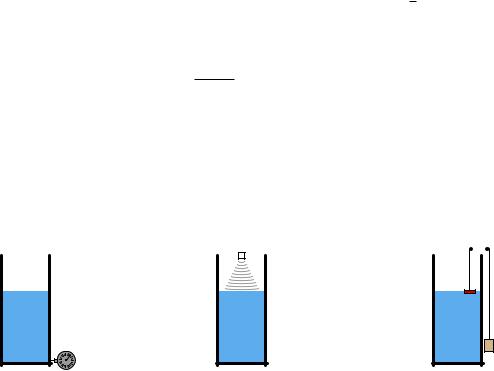
26.3. MATERIAL VOLUME MEASUREMENT |
2069 |
√
This in itself may be problematic, as some hand calculators do not have an x y function. In cases such as this, it is helpful to remember that a root is nothing more than an inverse power. Therefore, we could re-write the final form of the equation using a 23 power instead of a 32 root:
2
Q 3
3.367L
= H
26.3Material volume measurement
A variety of technologies exist to measure the quantity of stored material in a vessel. For liquid applications, hydrostatic pressure, radar, ultrasonic, and tape-and-float are just a few of the more common technologies:
Hydrostatic |
Radar or Ultrasonic |
Tape-and-Float |
||
|
|
|
|
|
|
|
|
|
|
Liquid |
Pressure sensor infers liquid level by measuring static pressure developed by the liquid ‘‘head’’
Liquid |
Radio or sound waves bounced off the liquid surface determine how far away the liquid is from the sensor
Liquid |
Float riding on liquid surface moves a metal cable or "tape," which directly registers level
These measuring technologies share a common trait: they infer the quantity of material stored in the vessel by measuring height. If the vessel in question has a constant cross-sectional area throughout its working height (e.g. a vertical cylinder), then material height will directly correspond to stored material volume. However, if the vessel in question does not have a constant cross-sectional area throughout its height, the relationship between material height and material volume will not be linear.
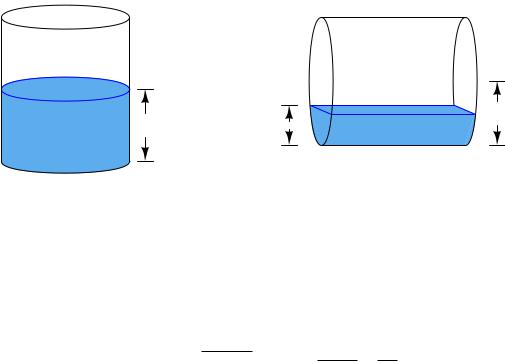
2070 |
CHAPTER 26. SIGNAL CHARACTERIZATION |
For example, there is a world of di erence between the height/volume functions for a vertical cylinder versus a horizontal cylinder:
 r
r 

|
h |
h |
r |
|
V |
V |
|||
|
|
The volume function for a vertical cylinder is a simple matter of geometry – height (h) multiplied by the cylinder’s cross-sectional area (πr2):
V = πr2h
Calculating the volume of material stored inside a horizontal cylinder as a function of material height (h) is a far more complicated matter, because the cross-sectional area is not constant. The solution to this problem is an exercise in integral calculus, the final result being this unwieldy function:
V = L (h − r)p2hr − h2 + r2 sin−1 (h − r) + πr2 r 2
Any instrumentation system inferring stored material volume by measurement of material height in a horizontal cylinder must somehow apply this formula on a continuous basis. This is a prime example of how digital computer technology is essential to certain continuous measurement applications!

26.3. MATERIAL VOLUME MEASUREMENT |
2071 |
Spherical vessels, such as those used to store liquefied natural gas (LNG) and butane, present a similar challenge: the material height/volume function is more complicated than for a vertical cylinder because the cross-sectional area of a spherical vessel changes with height. Once again an exercise in integral calculus is necessary to derive a formula for calculating the stored volume of material inside a sphere based on material height:
r |
r |
|
V |
h |
h |
V |
|
|||
|
|
|
Whereas the material volume function for a vertical cylinder is a simple linear formula (V = πr2h), the material volume formula for a sphere is a bit more complicated although not as complicated as it is for a horizontal cylinder:
V = πh2 |
r − 3 |
|
|
|
|
h |
|
This function will “un-do” the inherent height/volume nonlinearity of a spherical vessel, allowing a height measurement to translate directly into a volume measurement. A “characterizing” function such as this is typically executed in a digital computer connected to the level sensor, or sometimes in a computer chip within the sensor device itself.
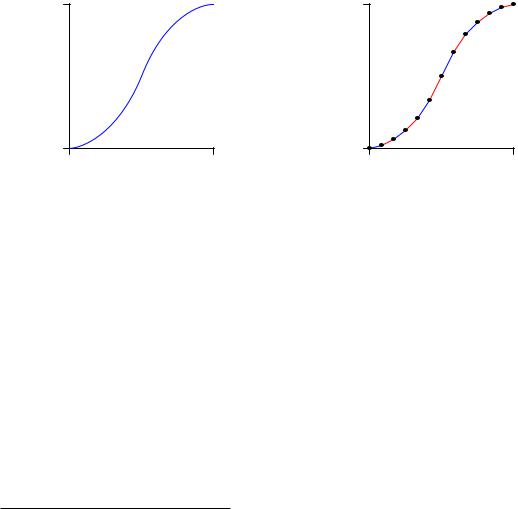
2072 |
CHAPTER 26. SIGNAL CHARACTERIZATION |
An interesting alternative to a formal equation for linearizing the level measurement signal is something called a multi-segment characterizer function, typically implemented as a function block inside a digital loop controller or distributed control system (DCS). This is an example of what mathematicians call a piecewise function: a function made up of line segments. Multi-segment characterizer functions may be programmed to emulate virtually any continuous function, with reasonable accuracy:
Continuous characterizing function |
Piecewise characterizing function |
Full |
|
|
Full |
|
|
V |
|
|
V |
|
|
Empty |
h |
|
Empty |
h |
|
0 |
D |
0 |
D |
The computer correlates the input signal (height measurement, h) to a point on this piecewise function, linearly interpolating between the nearest pair of programmed coordinate points. The number of points available for multi-point characterizers varies between ten and one hundred2 depending on the desired accuracy and the available computing power.
2There is no theoretical limit to the number of points in a digital computer’s characterizer function given su cient processing power and memory. There is, however, a limit to the patience of the human programmer who must encode all the necessary x, y data points defining this function. Most of the piecewise characterizing functions I have seen available in digital instrumentation systems provide 10 to 20 (x, y) coordinate points to define the function. Fewer than 10 coordinate points risks excessive interpolation errors, and more than 20 would just be tedious to configure.
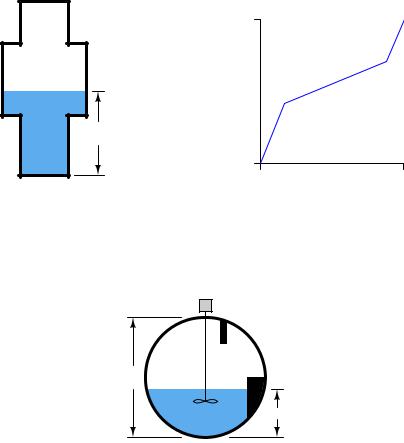
26.3. MATERIAL VOLUME MEASUREMENT |
2073 |
Although true fans of math might blanch at the idea of approximating an inverse function for level measurement using a piecewise approach rather than simply implementing the correct continuous function, the multi-point characterizer technique does have certain practical advantages. For one, it is readily adaptable to any shape of vessel, no matter how strange. Take for instance this vessel, made of separate cylindrical sections welded together:
|
D |
|
|
Liquid |
h |
|
|
|
|
|
|
|
h |
|
|
|
0 |
V |
|
|
Empty |
Full |
Here, the vessel’s very own height/volume function is fundamentally piecewise, and so nothing but a piecewise characterizing function could possibly linearize the level measurement into a volume measurement!
Consider also the case of a spherical vessel with odd-shaped objects welded to the vessel walls, and/or inserted into the vessel’s interior:
D 
h
The volumetric space occupied by these structures will introduce all kinds of discontinuities into the transfer function, and so once again we have a case where a continuous characterizing function cannot properly linearize the level signal into a volume measurement. Here, only a piecewise function will su ce.
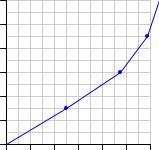
2074 |
CHAPTER 26. SIGNAL CHARACTERIZATION |
To best generate the coordinate points for a proper multi-point characterizer function, one must collect data on the storage vessel in the form of a strapping table. This entails emptying the vessel completely, then filling it with measured quantities of material, one sample at a time, and taking level readings. The result of this exercise is a data table correlating known volumes of material inside the vessel with measured heights of that material:
Introduced material volume |
Measured material level |
|
|
|
|
150 |
gallons |
2.46 feet |
300 |
gallons |
4.72 feet |
|
|
|
450 |
gallons |
5.8 feet |
600 |
gallons |
(etc., etc.) |
|
|
|
750 |
gallons |
(etc., etc.) |
Each of these paired numbers would constitute the coordinates to be programmed into the characterizer function computer by the instrument technician or engineer:
600 |
|
|
|
|
|
|
500 |
|
|
|
|
|
|
400 |
|
|
|
|
|
|
V |
|
|
|
|
|
|
(gallons) 300 |
|
|
|
|
|
|
200 |
|
|
|
|
|
|
100 |
|
|
|
|
|
|
0 |
|
|
|
|
|
|
0 |
1 |
2 |
3 |
4 |
5 |
6 |
|
|
h (feet) |
|
|
|
|
With this programmed function, the computer is able to infer material volume quite accurately from the height measurement reported by a level transmitter.

26.3. MATERIAL VOLUME MEASUREMENT |
2075 |
Many “smart” level transmitter instruments possess enough computational power to perform the level-to-volume characterization directly, so as to transmit a signal corresponding directly to material volume rather than just material level. This eliminates the need for an external “level computer” to perform the necessary characterization. The following screenshot was taken from a personal computer running configuration software for a radar level transmitter3, showing the strapping table data point fields where a technician or engineer would program the vessel’s level-versus-volume piecewise function:
This configuration window actually shows more than just a strapping table. It also shows the option of calculating volume for di erent vessel shapes (vertical cylinder is the option selected here) including horizontal cylinder and sphere. In order to use the strapping table option, the user would have to select “Strapping Table” from the list of Tank Types. Otherwise, the level transmitter’s computer will attempt to calculate volume from an ideal tank shape.
3The configuration software is Emerson’s AMS, running on an engineering workstation in a DeltaV control system network. The radar level transmitter is a Rosemount model 3301 (guided-wave) unit.
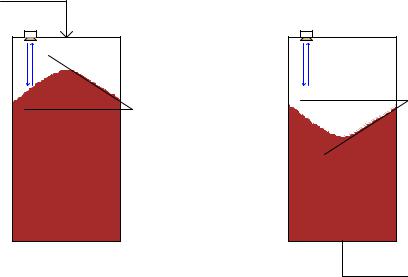
2076 |
CHAPTER 26. SIGNAL CHARACTERIZATION |
Solids material volume measurement poses unique problems over liquid material volume measurement, because solids – unlike liquids – are not self-leveling. A common problem encountered in measuring the level of a solid (chip, granular, or powder) inside a vessel is the angle of repose created when that material forms a pile inside the vessel:
Feed
Level sensor |
Level sensor |
||||
|
|
|
|
|
|
|
|
|
|
|
|
Angle of repose
Angle of repose
 Draw
Draw
It should be clear from the above illustration that any level sensor detecting the level of the solid material at any one point inside the vessel will usually yield a misleading result because it cannot sense variations in material level across the whole surface. This problem exists regardless of level sensor type (e.g. ultrasonic, radar, tape) so long as that sensor only senses material level at one point. Liquid material applications do not pose this problem because liquids naturally self-level, achieving a relatively flat surface by nature.
A modern solution to this measurement problem is to use an array of echo-based sensors to generate a three-dimensional map of the solid material surface, and then compute material volume based on all height measurements spanning the vessel’s cross-section. One such instrument designed for this purpose is Rosemount’s model 5708 3D Solids Scanner.
